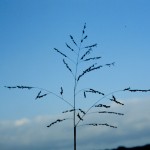Kleingrass , Klinegrass
Panicum coloratum L.
Poaceae
Description
Kleingrass is a perennial, warm-season, introduced species. It is a tufted bunch grass with stems arising from the firm, often knotty bases. It grows stems measuring 20 to 50 inches or 50 to 127 cm tall. The plant gives rise to an open flowering head with rounded seeds. The seedhead is fan-shaped and has fine branches similar to Switchgrass (Panicum virgatum). Kleingrass reproduces by rhizomes and seeds. Excellent grazing for livestock but may cause photosensitization (liver damage and death) in horses, sheep, and goats. Hay will cause similar problems. Fair grazing for wildlife; produces seeds for birds and small mammals. Kleingrass also provides cover for nesting birds and small mammals.Habitat
Not native to Texas, the grass was introduced from Africa in the 1950s. It is adapted to a variety of soils and habitat types. Kleingrass is also drought tolerant. After more than 10 years of research, Kleingrass 75 was released in 1969 as the most desirable variety, through joint efforts of the Texas AgriLife Extension Service and the U.S. Soil Conservation Service. In the past 45 years, hundreds of thousands of acres in Texas have been planted to a monoculture of Kleingrass.Toxic Agent
If managed properly, Kleingrass provides abundant good-quality forage for cattle. However, saponins in the grass are suspected to cause liver damage in horses, sheep, and goats, with accompanying photosensitization in small ruminants. Cattle appear to be unaffected. Regrowth after moisture or grazing/defoliation is reported to be more toxic than old or dormant growth.Signs of Livestock Ingestion
Poisoned sheep and goats exhibit typical signs of hepatogenous (secondary) photosensitivity, including: Discharge from the eyes and nose; Sunburn and edema of skin on the muzzle, eyes and nose progressing to tissue death. Examination after death may reveal liver inflammation and lesions. Small bile ducts may be obstructed. Kidneys and adrenal glands may also show lesions. Researchers have reported toxic signs in sheep (swellhead) after several weeks of grazing; in other cases, signs appeared after only a few days. If not removed from pastures, up to 100 percent of affected animals can die. Horses are also susceptible to Kleingrass toxicity, but unlike sheep, they do not exhibit classical signs of photosensitivity. Therefore, detecting poisoning early may be difficult. A serum chemistry profile can be very helpful. Poor body condition and weight loss (i.e., "hard keepers") may be the only early signs. With long-term exposure, liver damage may be lethal in horses.Management Strategies
Cattle are not reported to be susceptible to Kleingrass-induced photosensitivity. Therefore, they are the best species to graze Kleingrass pastures. If other livestock species have access to Kleingrass, use caution. Monitor animals closely, and limit the time spent grazing Kleingrass, especially when the grass is green and growing. Rotational grazing to other grass species may help. Most animals showing clinical signs recover when Kleingrass is removed from the diet. Horses should not be fed Kleingrass.Images
Plant Characteristics
Seed Type: Non-Encapsulated
Duration: Perennial
Stem Texture: Hairless/Smooth
Growth Habit: Bunch grass, Grasses
Leaf Shape
 : Simple with Pinnate or Parallel Venation
: Simple with Pinnate or Parallel Venation
Season: Warm
Distribution
 : 02 - Gulf Prairies and Marshes, 03 - Post Oak Savannah, 04 - Blackland Prairies, 05 - Cross Timbers and Prairies, 06 - South Texas Plains, 07 - Edwards Plateau
: 02 - Gulf Prairies and Marshes, 03 - Post Oak Savannah, 04 - Blackland Prairies, 05 - Cross Timbers and Prairies, 06 - South Texas Plains, 07 - Edwards Plateau
Distributions
Distribution refers to the ecological region in Texas that a plant has been found. You can also view a clickable map.
Book: Know Your Grasses (B-182), Toxic Plants of Texas (B-6105)
Collection: Grasses, Toxics
Livestock Affected: Goats, Horses, Sheep
Livestock Signs: Loss Of Weight, Photosensitization





